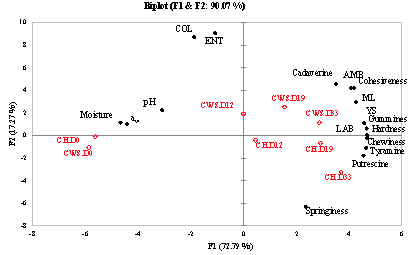 |
|
Paprika is the main spice used in the elaboration of chorizo contributing to both color and flavor, but until now there have not been studies evaluating its role in the sausage quality parameters. Therefore, our aims were: to know the effect of paprika on the quality parameters during ripening of chorizo, estimating an optimal time, and to simultaneously explore the evolution of biogenic amines during this operation. Two types of chorizo, one with paprika (CH) and the other without paprika (CWS), ripened for 33 days, were prepared for this study. Physico-chemical, texture and microbiological analyses were carried out. Additionally, the biogenic amines: tyramine, cadaverine and putrescine were analyzed by high-performance thin-layer chromatography (HPTLC) at 0, 12, 19 and 33 days. At day 19, the sample with paprika obtained the pH and aw values of 4.9 and 0.90, respectively, the highest growth of lactic acid bacteria, and a decrease in the coliform bacteria group and Enterobacteriaceae family. The total content of biogenic amines also decreased, mainly cadaverine, while tyramine content was lower than 100 mg/kg. In general, paprika favored the development and quality parameters of chorizo after 19 days of ripening and preserved the product for a longer time.
Keywords: chorizo, paprika, quality indicators, biogenic amines, HPTLC.
|
|
 |

